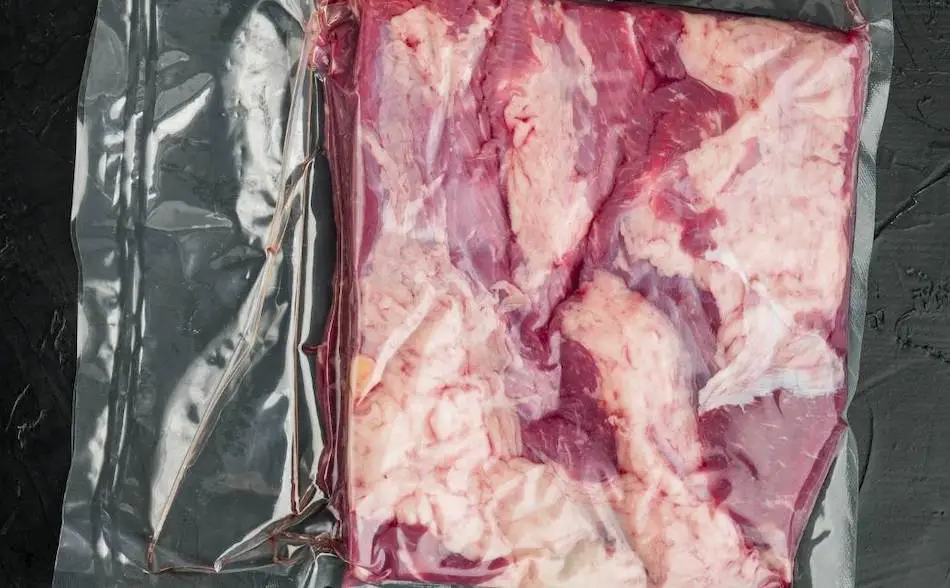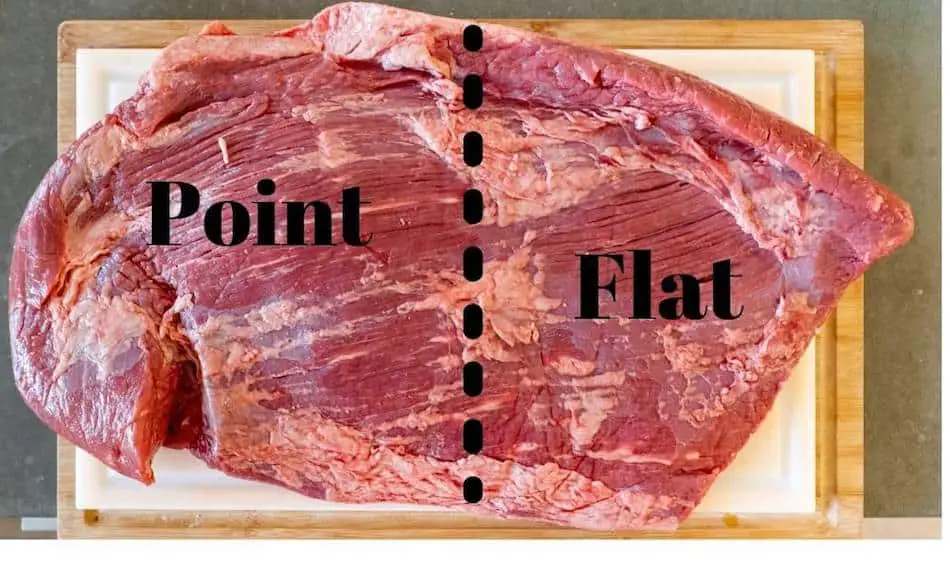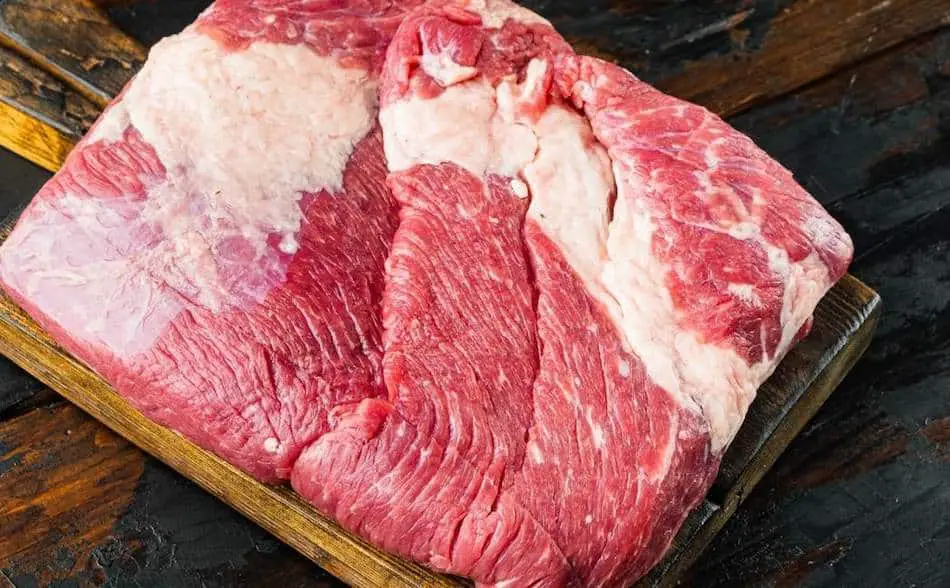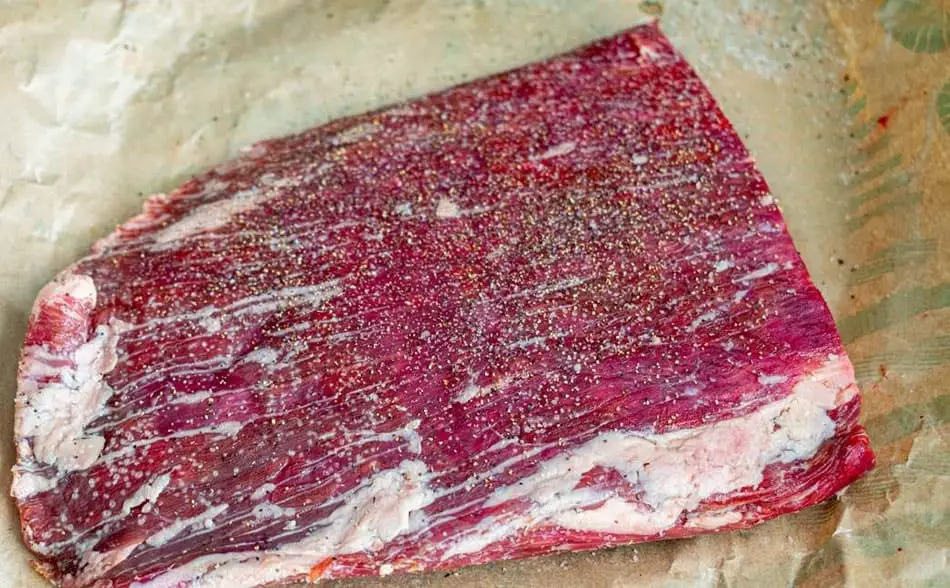
Brisket is divided into two muscles: a point and a flat. Even though these two muscles belong to the brisket, there are some important differences. A brisket flat is the most vulnerable part of the brisket, so it needs to be cooked differently. In this article, I did some research to find out the best way to prepare, and cook a brisket flat.
Where Does Brisket Come From?
Every cow has two briskets, AKA – pectoral muscles. These hard working muscles are the reason brisket takes so long to cook. However, when cooked low-and-slow, all that tough connective tissue melts and transforms into arguably the most flavorful meat on the planet.
A full brisket has two muscles; a point and a flat. The larger oval-shaped muscle is known as the point, and the thinner, longer muscle is called the flat. The flat is a much leaner part of the brisket because it is pure muscle. A butcher may sell brisket as a whole piece, or separate the flat from the point and sell the two muscles as smaller roasts.

The Flat vs Point
- A brisket flat is a lean muscle that can dry out easily when cooking.
- The flat sometimes has no fat cap.
- The flat cooks faster than the point.
- The meat grain on a flat runs in a different direction than the flat. So we should slice the meat in a different direction.
- The point is much easier to manage because it has a thick layer of fat for protection during long cooks.
- The point is thicker, so it can withstand more heat.
- When cooking a whole brisket, the flat can easily burn or dry out before the point.
- Brisket point contains a lot of fatty connective tissue.
- Some pitmasters remove the flat and cook it separately.
For more information, check out this article: The Point vs Flat Comparison.

How To Get The Best Out Of A Flat – 10 Tips
The flat is the most troublesome part of the brisket, which is why it isn’t a pitmaster’s first choice. However, sometimes flats can be cheap. With a few tips and tricks, you can still cook a flat to perfection.
- Face The Flat Away From The Heat. A brisket flat also has an awkward shape which makes it difficult to cook. Because the flat is thinner and the point, it will cook much faster. When cooking a whole brisket in the smoker, you often hear people say the thicker part of the brisket, the point, should face the heat source and the thinner flat muscle should face away from the heat. This is because the flat has a tendency to dry out quicker than the point.
- Slice The Flat In A Different Direction. When slicing a brisket after cooking, separate the point and the flat because the grain runs in different directions. As you may already know, you should always slice against the grain if you want tender slices of meat.
- Buy High Grade Beef. If you are going to smoke a brisket flat, you’ll get better results by choosing Choice or Prime grade beef. A brisket flat from the Select grade beef will not have much marbling and therefore be more difficult to cook.
- Cook The Flat In A Pan. To keep the flat moist, some pitmasters cook the flat in an aluminium pan with liquid. Th downside is it will make the bark soggy. Pour in some broth or stock to give the flat some added moisture.
- Keep The Fat. The brisket flat is a lean muscle and has little to no fat. The point, however, has a thick fat layer on top. This fatty layer on the point will help protect the meat during the cook, but the flat is vulnerable. If your brisket flat has some fat on the bottom or the top, leave it on. Remove this silver skin because this will not render, but any other stuff at leave intact.
- Brine The Flat Prior To Cooking. Rubbing salt into the brisket flat will benefit the meat during the long cook. By salting the brisket at least two hours before cooking will give the salt time to penetrate the meat. I like to leave my brisket in the refrigerator overnight to get the salt plenty of time to work its way into the meat. The salt plays an important role during the cook, and it will not only add flavor, it will help the meat retain moisture. A brisket flat will lose much of its moisture when cooked over a long period, so it will appreciate all the help it can get.
- Inject The Flat. Since the flat is a lean muscle with little marbling, injecting the meat with broth is a good way to get some extra moisture into the flat. Pumping the meat will also give the brisket an enormous flavor boost. The best brisket injection going around is the Butcher BBQ Prime Brisket Injection. If you’re after a meat injector, you can pick up a stainless steel needle on Amazon for a reasonable price. For more information on brisket injection, check out an article I wrote a while back called: Should I Inject Brisket?
- Place Fat Trimming Above The Flat. A great tip I learned from a pitmaster is to place fat trimmings on the rack above the brisket flat. The fat will drip down onto the brisket and provide added moisture and flavor.
- Add Some Tallow. One of the hottest trends and barbecue is beef tallow on brisket. Tallow is simply fat that has been cooked down and had all the impurities removed. It’s easy to make with brisket trimmings. Simply place your fat trimmings in a pan and cook the fat alongside the brisket. At the wrapping stage, pour the tallow over the brisket, or underneath. This will add extra flavor and moisture to the brisket. If you want to know more about beef tallow, I’ll walk you through the entire process in this article: Tallow on Brisket.

How To Cook A Brisket Flat
The best temperature to cook a brisket flat is around 220°F. At this temperature, it should take 6 to 10 hours depending on the size. If you want the flat done a little faster, raise the temperature of your smoker to 250°F, and this should take about 6 or 7 hours to cook the flat.
When Is It Done?
Brisket flat is done once the internal meat temperature reaches 203°F. improving the brisket with an instant-read thermometer once the brisket reaches 195°F. Some people prefer to go by feel rather than temperature. The brisket should feel like butter when poked with a probe.
Do You Wrap The Flat?
Wrapping is in essential step when smoking a brisket flat. Brisket is cooked in two stages, wrapped and wrapped. During the first stage of the cook, the brisket flat will absorb the smoke and the rub my role in the bark formation. Once the brisket flat reaches between 160°F and 170°F, then it is time to wrap. Wrapping will protect the brisket flat from drying out and help push the meat through the stall.
You can use either butcher paper or foil on the flat. Butcher paper will help the brisket breathe, and it will protect the bark. Aluminium foil, however, will create more steam and almost braise the brisket flat. For more information on wrapping brisket, check out this article I wrote a while back: Foil or Butcher paper – How Should I Wrap My Brisket?
Smoked Brisket Flat

Ingredients
- Brisket flat
- Barbecue rub
- Binder (olive oil or yellow mustard)
- Spritz (apple cider vinegar or apple juice).
Instructions
- Trim fat cap to 1/4 inch but leave fat on the bottom.
- Dry brine with kosher salt and leave several hours in refrigerator (overnight if possible)
- Inject with broth or marinade * Optional
- Apply binder (slather) * Optional
- Sprinkle rub on both sides.
- Bring smoker up to 220°F
- Throw on a few chunks of wood
- Place brisket flat in the smoker
- Place flat in a pan. *Optional
- Mop/spritz every hour.
- Wrap once the internal temp reaches 150°F (or when the brisket is dark and the bark has developed)
- Cook until the internal temperature reaches 203°F.
- Rest for 1 hour, or hold in a dry cooler for up to 4 hours or longer.
Nutrition Information:
Serving Size:
3 ozAmount Per Serving: Calories: 238
The Brisket Point
The brisket point is a large muscle that contains a lot of fatty connective tissue. If you cook too fast the point, the meat will be chewy. When the brisket point has the opportunity to remain in a low heat for a long period, all the connective tissue will melt into a gelatin like texture. Because the point has a lot of fat, it will also have more flavor.
My Favorite Brisket Tools
Thanks for checking out this article. I hope you learned a few things. Here are some of my favorite tools I use when smoking brisket that may be useful to you. These are affiliate links, so if you decide to purchase any of these products, I’ll earn a commission. But in all honesty, these are the tools I recommend to my family and friends who are just starting out.
Meat Injector: Injecting meat is a great way to take your barbecue to the next level and help you make competition-style brisket. An injector is the only way you will be able to get flavor and moisture into the middle of the meat. The Beast Injector is a stainless steel injector that is sturdy and affordable. Check the latest price on Amazon here.
Brisket Marinade: The best injection solution on the market is the Butcher BBQ Brisket Injection. This marinade is used in competitions and is made by World Barbecue Champion pitmaster, Dave Bouska. You can find the marinade on Amazon here.
Butcher Paper: Wrapping brisket in butcher paper has become a huge trend in barbeque thanks to Aaron Franklin. Wrapping your brisket in paper will give you a nice brisket bark. However, you can’t just use any old paper, it has to be unwaxed, food grade paper. You can find it on Amazon here.
Brisket Rub: These days I make my own rub when possible, but I always have a few pre-made rubs for when I’m running low. Barbecue guru Malcom Reed produces Killer Hogs, one of the best brisket rubs I’ve found over the years. Another great rub is Slap Yo Daddy, made by brisket master and multiple World Barbecue Champion, Harry Soo.
Meat Thermometer: There are dozens of fancy thermometers on the market, but I still use my trusty TP20. For around $50, I have a high-quality meat thermometer with two probes, and can track the temperature of my smoker with one probe, and my meat with the other probe. The ThermoPro TP20 is an Amazon Best Seller because it’s the easiest thermometer to operate, is durable, highly accurate, and comes with pre-programmed meat settings.
Instant Read Thermometer: Arguably, the second most important tool you need is a fast and accurate instant-read thermometer. These tools play an important role in the latter stages of the cook when the meat needs regular checking in multiple areas. I use the ThermoPro TP19 because it can do everything a ThermaPen can do, but for a fraction of the cost. You can check out the TP19 on Amazon here.
Advanced Thermometer and Automatic Temperature Controller: Once you’re ready to take things seriously, the FireBoard 2 Drive is a six-channel Bluetooth/Wi-Fi thermometer that can monitor up to 6 pieces of meat, control and graph your cook sessions on your smartphone, and attaches to an an automatic blower that will convert your charcoal smoker to a set-and-forget. This is one of the most advanced meat thermometers on the market. You can check it out on the FireBoard website here.
